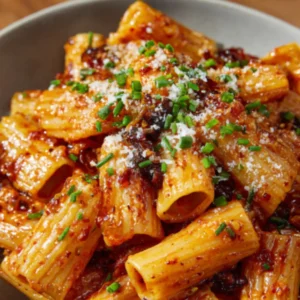Gochujang Pasta is a quick and tasty dish that mixes spicy Korean chili paste with creamy pasta sauce. It comes together in about 20 minutes and makes a great meal when you want something easy but full of flavor. This recipe uses simple ingredients and gives you a rich, spicy, and creamy pasta that everyone will enjoy.
Why You’ll Love This Gochujang Pasta Recipe
This pasta isn’t just another bowl of noodles; it’s a culinary adventure that combines the best of two worlds. You get the spicy warmth of Korean cuisine tempered by the creamy, cheesy goodness typical of Italian dishes. It’s quick to prepare, using pantry staples you likely already have, yet the flavor is anything but ordinary. Plus, the sauce clings beautifully to the rigatoni or any pasta shape you choose, giving every bite a perfect balance of heat and richness. If you enjoy bold tastes but want an easy recipe with minimal fuss, this is it.
Ingredients You’ll Need for Gochujang Pasta
To bring this dish to life, gather the following ingredients:
- 8 ounces of dried pasta — rigatoni, fusilli, spaghetti, or your favorite kind
- 6 cloves garlic, minced finely to release their aroma
- 1 medium shallot, diced for a mild onion flavor
- 3 tablespoons unsalted butter, for that silky base
- 2 and a half tablespoons gochujang paste — this is your spicy-sweet star
- 1 and a quarter cups heavy cream to create the luscious sauce
- 1 tablespoon oyster sauce for a savory depth (optional but recommended)
- One-third cup freshly grated Parmesan cheese — about 25 grams
- Half a cup of reserved pasta water, which helps the sauce bind and loosen as needed
For garnish:
- More Parmesan cheese, freshly grated
- Chopped chives to add freshness and color
How to Make Gochujang Pasta: Step-by-Step Directions
Start by boiling a large pot of salted water over high heat. Once it’s bubbling, add your pasta and cook until it’s al dente — firm but tender to the bite. Before draining, save about half a cup of the pasta water; this starchy liquid is essential for your sauce.
While the pasta cooks, melt the butter in a large skillet over medium-low heat. Add the minced garlic and diced shallots, sautéing gently until they release their fragrance and start to turn golden, which should take about two minutes. This slow cooking draws out sweetness and softens the shallots perfectly.
Next, stir in the gochujang paste. Cook it with the garlic and shallots for about two minutes, which helps mellow the sharpness of the chili paste while infusing the butter with vibrant flavor.
Pour in the heavy cream and add the oyster sauce. Stir constantly and let the mixture cook until it thickens slightly, roughly four to five minutes. This creamy base will be the hallmark of your sauce, balancing heat and richness.
Add the drained pasta directly into the skillet. Toss well to coat the noodles in the sauce. Sprinkle in the Parmesan cheese and gradually stir in the reserved pasta water, a little at a time, until the sauce reaches a smooth, creamy consistency that clings to each piece of pasta. Let everything cook together for an additional minute or two to meld flavors.
Finally, serve the pasta garnished with extra Parmesan cheese and a scattering of chopped chives for a fresh pop of green and mild oniony flavor.
How to Serve Your Gochujang Pasta for the Best Experience
For serving, present your pasta in warm bowls or plates to keep it cozy and inviting. The creamy sauce tends to thicken as it cools, so serve it right away to enjoy the perfect texture. This dish pairs well with a simple side salad dressed with a light vinaigrette to cut through the richness. A crisp vegetable like steamed broccoli or sautéed spinach can add a nice contrast, both in taste and color. If you want to elevate the meal, add a sprinkle of toasted sesame seeds or a few thin slices of fresh chili on top for extra heat and crunch.
Expert Tips to Perfect Your Gochujang Pasta
- Adjust the heat by varying the amount of gochujang you use. Start with less if you prefer milder spice, then add more after tasting.
- Use freshly grated Parmesan cheese for the best melt and flavor; pre-grated versions often lack creaminess.
- Reserve extra pasta water beyond the suggested amount — it’s a handy tool if your sauce thickens too much.
- When sautéing garlic and shallots, keep the heat moderate to avoid burning, which can cause bitterness.
- If heavy cream is too rich for your liking, substitute half with whole milk, but the sauce will be less thick.
How to Store Leftover Gochujang Pasta
If you have leftovers, place the pasta in an airtight container and refrigerate it within two hours of cooking. It will stay fresh for up to three days. When reheating, add a splash of water or cream to loosen the sauce, warming it gently over low heat or in the microwave to avoid drying out. Avoid freezing this dish, as the cream sauce may separate and become grainy once thawed.
Variations to Customize Your Gochujang Pasta
You can easily tweak this recipe to suit your tastes or dietary needs. Try swapping heavy cream with coconut cream for a dairy-free option that still offers richness. Add cooked chicken, shrimp, or tofu for a protein boost. Incorporate vegetables like mushrooms, bell peppers, or spinach during the sauté step for added nutrition and texture. For an extra layer of flavor, sprinkle crushed red pepper flakes or drizzle a bit of toasted sesame oil just before serving. You might also experiment with different pasta shapes—shells or penne work beautifully to hold onto the creamy sauce.
Frequently Asked Questions About Gochujang Pasta
What is gochujang?
Gochujang is a Korean chili paste that’s spicy, slightly sweet, and fermented. It adds a unique depth of flavor to dishes, balancing heat with umami.
Can I use other pasta types?
Absolutely! Rigatoni is ideal because it holds sauce well, but fusilli, spaghetti, or penne also work fine, depending on your preference.
Is oyster sauce necessary?
Oyster sauce enhances the savory taste, but if you don’t have it or want to avoid seafood ingredients, you can skip it or substitute with soy sauce.
How spicy is this pasta?
The heat level depends on how much gochujang you add. It has a moderate spiciness, but you can adjust it to be milder or hotter.
Can I make this dish vegan?
To veganize, swap butter with a plant-based alternative, use coconut cream instead of heavy cream, and omit Parmesan or replace it with a vegan cheese.

Gochujang Pasta
Ingredients
- 8 ounces dried pasta (rigatoni, fusilli, spaghetti, or your choice)
- 6 cloves garlic (minced)
- 1 medium shallot (diced)
- 3 tablespoons unsalted butter
- 2 1/2 tablespoons gochujang paste
- 1 1/4 cups heavy cream
- 1 tablespoon oyster sauce (optional)
- 1/3 cup freshly grated Parmesan cheese (about 25 grams)
- 1/2 cup reserved pasta water
- to taste freshly grated Parmesan cheese (for garnish)
- to taste chopped chives (for garnish)
Instructions
- Boil a large pot of salted water. Add pasta and cook until al dente. Reserve about 1/2 cup of pasta water before draining.
- In a large skillet over medium-low heat, melt the butter. Add minced garlic and diced shallots, sautéing until fragrant and golden, about 2 minutes.
- Stir in gochujang paste and cook for 2 minutes to mellow its flavor.
- Pour in heavy cream and oyster sauce (if using). Stir and let the mixture cook until slightly thickened, about 4-5 minutes.
- Add drained pasta to the skillet, tossing to coat. Sprinkle in Parmesan cheese and gradually stir in reserved pasta water until the sauce is creamy and clings to the pasta.
- Serve garnished with extra Parmesan cheese and chopped chives.
Send me this recipe!
Just enter your email below and get it sent straight to your inbox!


